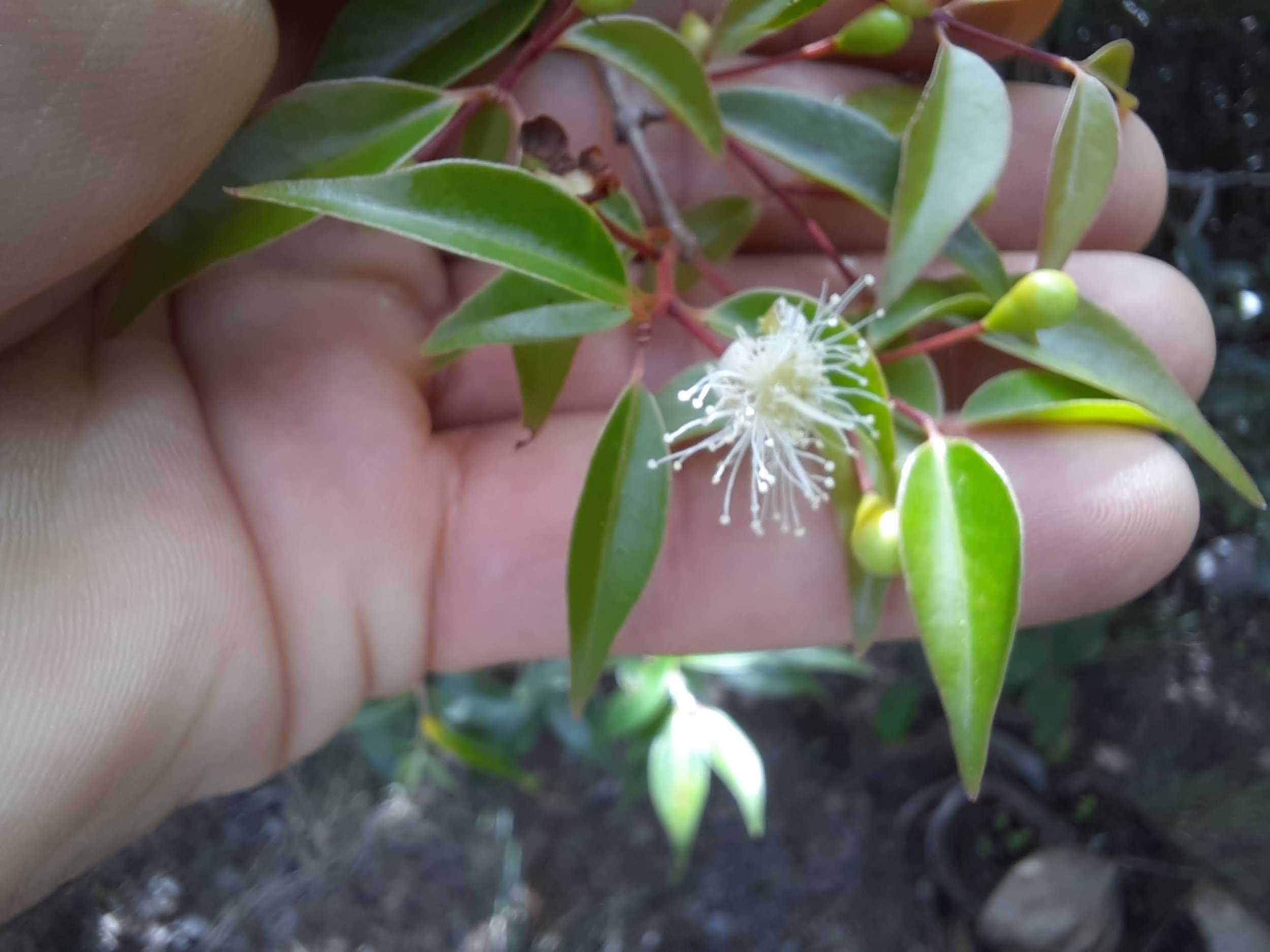Psidium Oligospermum
Seeds were imported from Brazil. This is an accept species. This is a species which grows as a tree up to 2 m high when cultivated, but when in the forest it can reach up to 4 m in height. The crown is irregular and branchy, with the branches at the ends drooping. The trunk is cylindrical, tortuous, measuring 5 to 10 cm in diameter. The rhytidome or bark is smooth, with grayish and whitish colors; and once a year the bark falls off. Young branches are glabrous (hairless) and cylindrical. The leaves are simple, opposite, cardaceous (like cardboard), and glabrous (without hairs), attached by a petiole (stem or support) 2 to 3 mm long. The blade (leaf tissue) measures 2 to 4.5 cm long by 1 to 1.5 cm wide. The base is the contour, and the apex is acuminate (with a long point). The open flower is white, fragrant and measures 1 cm in diameter, being formed by a calyx (external envelope) with 4 to 5 lobes or indentations in the form of concave teeth that break at anthesis. The corolla is formed by 5 white petals of 3 to 4 mm in length that mix with the white and long stamens (male tubes). The fruits are piriform berries (pear-shaped) 1.3 to 2.3 cm in diameter with a thin skin that is yellowish and golden in color when fully ripe. The pulp is whitish, acidic, involving 3 to 6 angular and very hard seeds, resembling stones.
Seeds were imported from Brazil. This is an accept species. This is a species which grows as a tree up to 2 m high when cultivated, but when in the forest it can reach up to 4 m in height. The crown is irregular and branchy, with the branches at the ends drooping. The trunk is cylindrical, tortuous, measuring 5 to 10 cm in diameter. The rhytidome or bark is smooth, with grayish and whitish colors; and once a year the bark falls off. Young branches are glabrous (hairless) and cylindrical. The leaves are simple, opposite, cardaceous (like cardboard), and glabrous (without hairs), attached by a petiole (stem or support) 2 to 3 mm long. The blade (leaf tissue) measures 2 to 4.5 cm long by 1 to 1.5 cm wide. The base is the contour, and the apex is acuminate (with a long point). The open flower is white, fragrant and measures 1 cm in diameter, being formed by a calyx (external envelope) with 4 to 5 lobes or indentations in the form of concave teeth that break at anthesis. The corolla is formed by 5 white petals of 3 to 4 mm in length that mix with the white and long stamens (male tubes). The fruits are piriform berries (pear-shaped) 1.3 to 2.3 cm in diameter with a thin skin that is yellowish and golden in color when fully ripe. The pulp is whitish, acidic, involving 3 to 6 angular and very hard seeds, resembling stones.
Seeds were imported from Brazil. This is an accept species. This is a species which grows as a tree up to 2 m high when cultivated, but when in the forest it can reach up to 4 m in height. The crown is irregular and branchy, with the branches at the ends drooping. The trunk is cylindrical, tortuous, measuring 5 to 10 cm in diameter. The rhytidome or bark is smooth, with grayish and whitish colors; and once a year the bark falls off. Young branches are glabrous (hairless) and cylindrical. The leaves are simple, opposite, cardaceous (like cardboard), and glabrous (without hairs), attached by a petiole (stem or support) 2 to 3 mm long. The blade (leaf tissue) measures 2 to 4.5 cm long by 1 to 1.5 cm wide. The base is the contour, and the apex is acuminate (with a long point). The open flower is white, fragrant and measures 1 cm in diameter, being formed by a calyx (external envelope) with 4 to 5 lobes or indentations in the form of concave teeth that break at anthesis. The corolla is formed by 5 white petals of 3 to 4 mm in length that mix with the white and long stamens (male tubes). The fruits are piriform berries (pear-shaped) 1.3 to 2.3 cm in diameter with a thin skin that is yellowish and golden in color when fully ripe. The pulp is whitish, acidic, involving 3 to 6 angular and very hard seeds, resembling stones.





